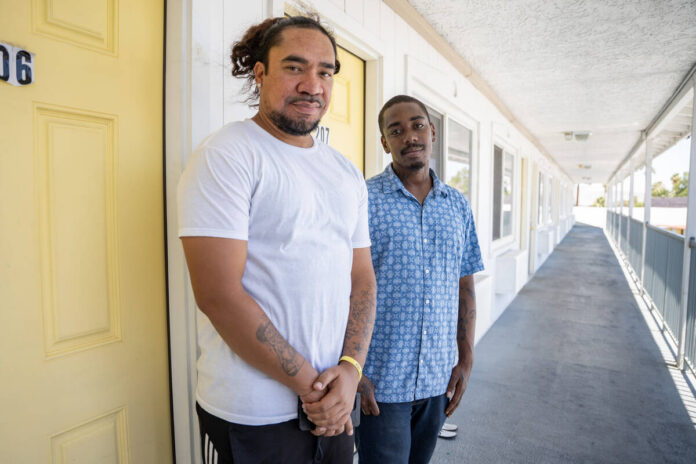In the heart of Las Vegas, a transformative initiative at Clark County’s Navigation Center is providing not just shelter, but also a vital lifeline for those grappling with housing insecurity. Recently, two residents, Steven Martin, 26, and Justin Golden, 37, shared their experiences at this resource hub, highlighting how the center is helping them regain stability and plan for a brighter future.
Martin, who aspires to attend barber school, expressed his hopes of establishing a permanent residence with his fiancé. His journey back to stability has been challenging, particularly after the couple’s recent job loss after relocating to Las Vegas. “It’s a good environment, they show me respect,” he noted, emphasizing the supportive atmosphere that fosters personal growth. Golden, on the other hand, has a profound motivation: to be a father to his newborn child, bringing into focus the personal stakes of his journey towards stability.
The pair’s path to the Navigation Center began when outreach teams found them loitering in local parks and encouraged them to seek the help available at the center. This proactive approach is essential in reaching those most in need, as many individuals experiencing homelessness may not be aware of the available resources. The Center, a product of repurposing an old motel into a 70-bed complex, has been operational as an intake facility for two years, allowing individuals to stay for a month while accessing crucial support services.
At the Navigation Center, residents benefit from a range of services designed to address their immediate needs and facilitate long-term stability. Social workers guide attendees through various programs aimed at finding permanent housing. Available resources include telehealth, mental health services, pharmacy access, and individualized case management. These services are tailored to ease the challenges faced by the unhoused, preventing feelings of overwhelm as residents work towards redefining their lives.
Marking its two-year anniversary, the Navigation Center celebrated a significant milestone: nearly 1,800 individuals have been assisted since the facility’s inception. County Commission Chair Tick Segerblom, present at the celebration, described it as the “first entry point” for individuals in crisis, affirming the importance of providing shelter, food, and hygiene facilities. “We have a room, shower, and food,” he said, underscoring the center’s critical role in supporting the community’s vulnerable populations.
The comprehensive nature of the services offered at the Navigation Center sets it apart as a pivotal model for addressing homelessness in Las Vegas. Brenda Barnes, Clark County Social Service Manager, affirmed that the structure provided allows individuals to tackle one barrier at a time. This method proves to be less daunting for residents and enables them to gradually regain their footing in society.
Despite the success stories emerging from the center, the broader context of homelessness in Southern Nevada presents significant challenges. A recent census revealed that over 7,900 individuals are living on the streets or in public shelters, representing a 20% increase from the previous year—marking the highest count in a decade. This uptick aligns with national trends, raising concerns among advocates and officials alike about the persistent challenges of homelessness.
Segerblom expressed hope that the Navigation Center model can be replicated across the valley, pointing out the acquisition of other shuttered motels for the same purpose. The forthcoming $200 million Campus for Hope complex is set to follow similar operational procedures, further expanding the support network for the unhoused. Segerblom emphasized that the initiative has the potential to greatly benefit his district, where homelessness is a pressing issue.
Community concerns regarding homelessness in residential neighborhoods have prompted further discussions among officials. The Navigation Center serves as a crucial alternative to arrests and interventions by law enforcement, offering a more humane approach to managing homelessness. With funding for each resident’s stay proving to be less costly than incarceration, the center represents a proactive investment in community health and stability.
However, the ongoing struggle to secure affordable housing remains a significant hurdle. The threat of federal funding cuts loom large, with Segerblom revealing collective fears about the financial sustainability of these essential services. “All of this is on a house of cards,” he lamented, highlighting the critical need for continued support at all levels.
Reflecting on their journeys, Martin and Golden painted a stark picture of life on the streets, grappling with extreme heat and the basic survival challenges that come with homelessness. Martin, for instance, experienced a dramatic weight loss of over 20 pounds during a year of living outdoors. “I felt lost before I met the social workers,” he admitted, expressing surprise that such programs existed to assist individuals in need.
Conversely, Golden opened up about his experiences of living outdoors or couch surfing, longing to find a stable home. “It’s a mental thing,” he stated, articulating the psychological struggle of adapting to uncertain living conditions. The support received at the Navigation Center has been instrumental in providing them with a sense of structure—a stark contrast to feeling overwhelmed by an unstable environment.
In sharing their stories, both Martin and Golden exemplify the resilience of individuals striving to overcome the barriers of homelessness, highlighting the need for continued resources and compassionate support. Through community engagement, targeted services, and ongoing advocacy, the Navigation Center serves as more than just a shelter; it’s a vital part of the journey towards healing and stability.
